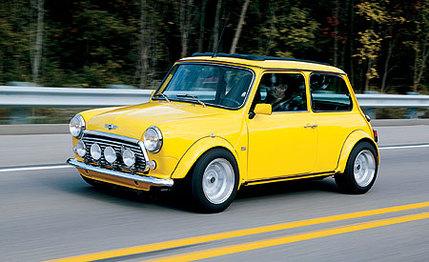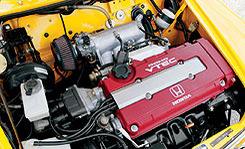
 Specialty File
Specialty File
Once upon a time when the mountains were young, import-car buyers were avant-garde. These half-mad radicals thought nothing of trading in a perfectly good De Soto Firesweep for —whoa!—an English car! They craved something quirky and agile like a Morris Minor or Hillman Minx that worked. Worked! Started every morning. Lasted decades. Sold for cheap.
Of course, you nod, they wanted a BMC Mini, but engineered by Honda.
And 40-plus years later, Mini Tec of Royston, Georgia, offers just that—a rorty 220-hp Honda VTEC four-cylinder engine mashed into an original Mini. The real BMC Mini. Two of these wee paperweights parked together look like a pair of dice. Mini Tec will sell you a couple—or just one—then run for the tall brush. They aren't afraid the car won't work; they're afraid it will.
The original Mini's charisma is so legendary that BMW gambled mega-millions—successfully—on its resurrection in 2001. But compared with the BMC Mini, BMW's version is a Peterbilt. The impossibly "cute" 1959 Mini designed by Sir Alec Issigonis still provokes helpless smiling. Among enthusiasts, ownership remains contagious; the minute one Issigonis Mini appears, the entire neighborhood must be dusted with flea-and-tick powder.
You're right, that's pure hyperbole. But with Minis, hyperbole is just good reporting. Add a dose of violent VTEC performance, and whoppers are automatic. The Mini Tec VTEC is one of the fastest, and, um, furious-est, drives south of a Z06. Just look at the numbers from the one we tested-1792 pounds and a claimed 220 horsepower. The Honda engine was originally for the Acura Integra Type R and was rated for 195 horsepower. But Mini Tec says better-breathing intake and exhaust systems add 25 ponies, and despite copious amounts of wheelspin, the VTEC Mini still scooted to 60 mph in 5.0 seconds.


But sliding a 21st-century VTEC into this Bronze Age Mini takes more than shoehorns and grease. Norman Holley, a Clemson graduate engineer, devised his Mini Tec B-series subframe to facilitate the VTEC Mini's Frankenstein-ism. The hood and the front fenders must be stretched forward four inches. (It's not noticeable until you're told it's there; then it looks cryptically cool.) The conversion doesn't change the stock Mini's front-suspension dimensions, welcoming any new or aftermarket Mini wheel. The Honda radiator has room to sit low, with no ugly hood modifications. A standard Mini brake servo and stock upper control arms and uprights combine with the standard Honda distributor and ECU. Camber, caster, and ride height are fully adjustable. Except for its invisible nose extension, the Mini Tec Mini is indistinguishable from a 35-hp '59 Mini.
From the pilot's seat it feels the same, too. If you've never sat in an original Mini, nothing can communicate its utter eensie-ness. But we'll try. One afternoon years ago, our friend John Clark retired from racing in a Mini, for cause. He is an XXL sorta guy, and his racing Mini Cooper S fit him like spandex. He was on the track annoying physics that day, tossing the 80.0-inch wheelbase— 80 inches!—side to side through the esses at great speed when, suddenly, the car took matters into its own hands. Rolling, leaping, and rolling, it closed in around him like aluminum foil around take-out fried chicken. Unhurt, but shaken and stirred, he was removed surgically and found other pursuits. The point? This little car feels nearly as wide as it is long, decidedly not the formula for high-speed stability—and with a VTEC under its chin, high speed is never far away. A word to the wise.